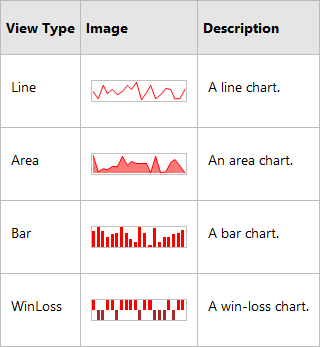Sparkline
The Sparkline control displays a compact chart that is commonly used to reflect the flow of data for every row in a report.

In the Property Grid, the Sparkline control's properties are divided into the following groups:
| Property | Description |
|---|---|
| Background Color | Specifies the background color for the control. |
| Borders, Border Color, Border Dash Style and Border Width | Specify border settings for the control. |
| Formatting Rules | Opens the Formatting Rules Editor, allowing you to choose which rules should be applied to the control during report generation, and define the precedence of the applied rules. To learn more on this, see Conditionally change a control's appearance. |
| Padding | Specifies indent values which are used to render the contents of the control. |
| Style Priority | Allows you to define the priority of various style elements (such as background color, border color, etc.). For more information on style inheritance, see Understand styles concepts. |
| Styles | Assigns an existing (or newly created) style to control, and also specifies Use odd and even styles. For more information on style inheritance, see Understand styles concepts. |
| View | Specifies the type of a chart displayed by a Sparkline control. The following table lists the available Sparkline view types. |

| Property | Description |
|---|---|
| Anchor Horizontally | Specifies the horizontal anchoring style of the control, so that after page rendering it stays attached to the left control, right control, or both. |
| Anchor Vertically | Specifies the vertical anchor style of the control, so that after a page is rendered it stays attached to the top control, bottom control, or both. |
| Scripts | This property contains events, which you can handle by the required scripts. For more information on scripting, see Handle events via scripts. |
| Visible | Specifies whether the control should be visible in Print Preview. |
| Property | Description |
|---|---|
| (Data Bindings) | This property allows you to bind some of a cell's properties (Bookmark, NavigateURL, Tag and Text) to a data field obtained from the report's data source, and to apply a format string to it. |
| Data Adapter | Determines a data adapter that will populate a pivot grid's data source which is assigned via the Data Source property. It is automatically set to the appropriate value, when the Data Member property is defined. |
| Data Member |
Determines the data source member which supplies data to a pivot grid. Note: Usually, it is not necessary to specify the Data Member property when binding a pivot grid to data. This property should only be set directly if the data set contains more than one table. |
| Data Source | Determines a sparkline's data source. |
| Tag |
This property allows you to add some additional information to the control; for example its id, by which it can then be accessible via scripts. The Tag property can be bound to a data field obtained from the data source. To do this, expand the (Data Bindings) property and in the Tag.Binding drop-down selector, select the required data field. |
| Value Member |
Specifies the data member field that provides point values for a Sparkline. |
| Value Range | Specifies the values indicating range limits. |
| Property | Description |
|---|---|
| (Name) | Determines a control's name, by which it can be accessed in the Report Explorer, Property Grid or via scripts. |
| Property | Description |
|---|---|
| Location | Specifies the control's location, in report measurement units. |
| Size | Specifies the control's size, in report measurement units. |
| Snap Line Margin | Specifies the margin (in report measurement units), which is to be preserved around the control when it is aligned using Snap Lines, or when other controls are aligned next to it. |
| Property | Description |
|---|---|
| Bookmarkand Parent Bookmark |
These properties are intended for the creation of a hierarchical structure within a report called a document map. For an explanation and help, see Add bookmarks. The Bookmark property can be bound to a data field obtained from the data source. To do this, expand the (Data Bindings) property and in the Bookmark.Binding drop-down selector, select the required data field. |
| Navigate URLand Target |
Use the Navigate URL property to specify a URL for web browser navigation when a user clicks a label. The web browser displays a page in a window or a frame as specified by the Target property. Note that a URL should have an appropriate prefix (e.g. "http://"). You can create cross-references within the report by assigning the name of the target control to the Navigate URL property, and setting the Target property to "_self". For more information, see Create hyperlinks. The Navigate URL property can be bound to a data field obtained from the data source. To do this, expand the (Data Bindings) property and in the Navigate URL.Binding drop-down selector, select the required data field. |
